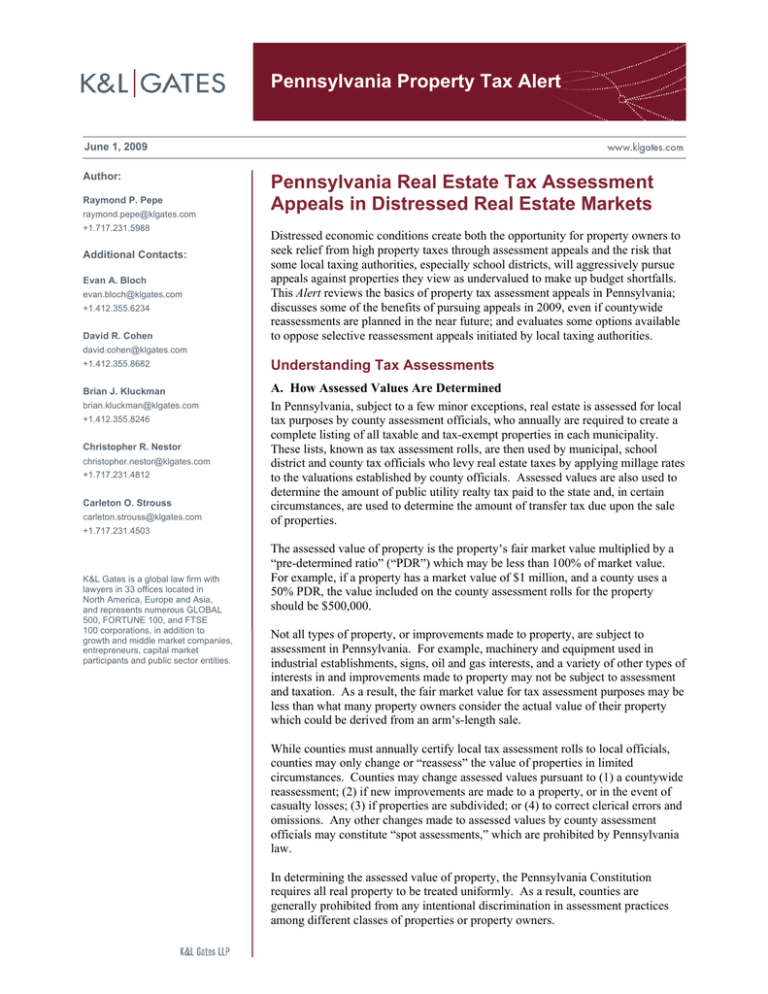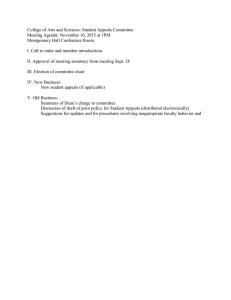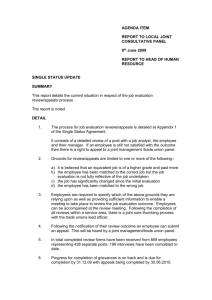
Pennsylvania Property Tax Alert
June 1, 2009
Author:
Raymond P. Pepe
raymond.pepe@klgates.com
+1.717.231.5988
Additional Contacts:
Evan A. Bloch
evan.bloch@klgates.com
+1.412.355.6234
David R. Cohen
Pennsylvania Real Estate Tax Assessment
Appeals in Distressed Real Estate Markets
Distressed economic conditions create both the opportunity for property owners to
seek relief from high property taxes through assessment appeals and the risk that
some local taxing authorities, especially school districts, will aggressively pursue
appeals against properties they view as undervalued to make up budget shortfalls.
This Alert reviews the basics of property tax assessment appeals in Pennsylvania;
discusses some of the benefits of pursuing appeals in 2009, even if countywide
reassessments are planned in the near future; and evaluates some options available
to oppose selective reassessment appeals initiated by local taxing authorities.
david.cohen@klgates.com
+1.412.355.8682
Understanding Tax Assessments
Brian J. Kluckman
A. How Assessed Values Are Determined
In Pennsylvania, subject to a few minor exceptions, real estate is assessed for local
tax purposes by county assessment officials, who annually are required to create a
complete listing of all taxable and tax-exempt properties in each municipality.
These lists, known as tax assessment rolls, are then used by municipal, school
district and county tax officials who levy real estate taxes by applying millage rates
to the valuations established by county officials. Assessed values are also used to
determine the amount of public utility realty tax paid to the state and, in certain
circumstances, are used to determine the amount of transfer tax due upon the sale
of properties.
brian.kluckman@klgates.com
+1.412.355.8246
Christopher R. Nestor
christopher.nestor@klgates.com
+1.717.231.4812
Carleton O. Strouss
carleton.strouss@klgates.com
+1.717.231.4503
K&L Gates is a global law firm with
lawyers in 33 offices located in
North America, Europe and Asia,
and represents numerous GLOBAL
500, FORTUNE 100, and FTSE
100 corporations, in addition to
growth and middle market companies,
entrepreneurs, capital market
participants and public sector entities.
The assessed value of property is the property s fair market value multiplied by a
pre-determined ratio ( PDR ) which may be less than 100% of market value.
For example, if a property has a market value of $1 million, and a county uses a
50% PDR, the value included on the county assessment rolls for the property
should be $500,000.
Not all types of property, or improvements made to property, are subject to
assessment in Pennsylvania. For example, machinery and equipment used in
industrial establishments, signs, oil and gas interests, and a variety of other types of
interests in and improvements made to property may not be subject to assessment
and taxation. As a result, the fair market value for tax assessment purposes may be
less than what many property owners consider the actual value of their property
which could be derived from an arm s-length sale.
While counties must annually certify local tax assessment rolls to local officials,
counties may only change or reassess the value of properties in limited
circumstances. Counties may change assessed values pursuant to (1) a countywide
reassessment; (2) if new improvements are made to a property, or in the event of
casualty losses; (3) if properties are subdivided; or (4) to correct clerical errors and
omissions. Any other changes made to assessed values by county assessment
officials may constitute spot assessments, which are prohibited by Pennsylvania
law.
In determining the assessed value of property, the Pennsylvania Constitution
requires all real property to be treated uniformly. As a result, counties are
generally prohibited from any intentional discrimination in assessment practices
among different classes of properties or property owners.
Pennsylvania Property Tax Alert
For example, assessments for all properties must
be based on the market values in the same base
year, or made pursuant to adjustments to reflect
differences between the base year and the year in
which a reassessment is conducted. Counties
may also be ordered to conduct countywide
reassessments if gross disparities emerge in the
extent to which various properties are under or
over-assessed based upon current market values.
B. Assessment Appeals
Notwithstanding the limitations on the
circumstances in which counties may initiate
reassessments, property owners and local taxing
authorities, i.e., cities, boroughs, townships and
school districts, may annually file assessment
appeals to request changes to assessed values.
Deadlines differ from county to county regarding
the filing of appeals, but with the exception of
Allegheny, Philadelphia and Wyoming Counties,
most deadlines fall on either August or
September 1st.1 Any appeals filed before the
requisite deadline will generally affect the
valuation of the property for local government
fiscal years beginning on or after January 1st of
the following year.2 In other words, timely
assessment appeals filed during 2009 will apply
to county and city, borough or township taxes
levied for calendar year 2010, and will apply to
school district taxes levied for the period from
July 1, 2010 to June 31, 2011.
Market values must generally be based on an
evaluation of comparable sales, construction
costs, and capitalized real or estimated rental
rates for property, and may never take into
consideration the value of property to operate a
particular business on a site or the income
generated by business activities independent of
the property interest itself (e.g. real estate rental
income may be taken into account). Owners of
property may always offer testimony regarding
the value of their property and others who qualify
as experts may also offer opinions regarding the
value of property.
1
The deadline in Allegheny County is March 31st, in
Philadelphia it is October 1st, and in Wyoming County it is
August 31st. Deadlines may be modified, however, from
year to year and should always be verified with local
officials.
2
In Allegheny County, comprising Pittsburgh and some
surrounding municipalities, appeals may be filed before
their March 31 deadline in the year in which the change in
assessment is sought.
Assessment appeals are conducted informally
before a local board appointed to hear appeals
(or in small some small counties before the
county commissioners) and generally are
disposed of promptly. Decisions of local
assessment appeal boards may be appealed to
county courts, which, based on expert testimony,
may make findings regarding the value of the
property to confirm or replace the valuations
made by the local appeals boards. The decisions
of county courts are further subject to an appeal
to the Pennsylvania Commonwealth Court to
review errors of law and whether the decisions
are based upon substantial evidence.
C. Adjustments to Market Values
Because political considerations sometimes deter
county officials from routine countywide
reassessments, the base year used to establish
property values in the most recent countywide
reassessment, or otherwise used to equalize
property values, may range from recent to many
years ago. When counties fail to make up-todate countywide reassessments, the
constitutional requirements that all property must
be valued uniformly poses some unique
challenges and opportunities for taxpayers in
pursuing assessment appeals.
To reflect the differences between current market
values and assessed values, an agency known as
the State Tax Equalization Board annually
publishes ratios that compare recent sales prices
of properties in each county to market values
based on the assessments of those properties.
The board publishes common level ratios
( CLRs ) that reflect the average ratio of
assessed value to market value. Where recent
countywide reassessments have not been
conducted, there is often a significant difference
between the predetermined ratios ( PDRs ) used
to derive assessed values from market values and
the CLRs as calculated by the State Board.
When pursuing tax appeals, taxpayers may elect
to have the value of their properties determined
using current market values subject to
adjustments to reflect changes that have occurred
since the base year. When the CLR for the year
being appealed varies by more than 15% from
the PDR, state law provides that assessed values
following appeals may be determined by
multiplying the fair market value by the CLR
rather than the PDR. For example, if during an
assessment appeal, it is determined a property
has a fair market value of $1 million and the
county uses a 50% PDR, but has a CLR of 30%,
the assessed value of the property would be set at
June 1, 2009
2
Pennsylvania Property Tax Alert
$300,000. Recent decisions by the Pennsylvania
Supreme Court may also entitle property owners
in other circumstances to have assessed values
determined using CLRs in assessment appeals.3
When a County adopts a base year for
valuation purposes, then taxpayers also have the
right to have their property valued at its base year
value rather than at its current market value.
Where taxpayers elect base year values,
assessment values are determined using
predetermined ratios and CLRs are not taken into
consideration. As a result, in pursing an appeal, a
taxpayer should always consider whether a
current market valuation adjusted by the CLR is
more beneficial than a base year valuation.
Pending the resolution of an assessment appeal,
taxes need to be paid based on the prior assessed
value, but taxpayers may subsequently seek
refunds of any excessive taxes paid. If taxes are
paid under protest during the pendency of appeal,
with notice of the payment under protest provided
to the taxing authorities, 25% of the taxes paid
are required to be held in escrow in order to pay
potential refunds. When assessed values are
changed as a result of assessment appeals, the
new values will apply to not only the year for
which the appeal was filed, but also to any
subsequent years for which new assessments are
pending the resolution of an appeal.4
Obtaining Fair Assessments in
Distressed Real Estate Markets
Although some parts of Pennsylvania have been
spared from the worst effects of the nationwide
distress in real estate markets, for many types of
properties in many communities, values have
fallen significantly in 2008 and 2009. Because
property owners have a right to expect that
their taxes will reflect fair valuations, 2009 may
be a good year in which to consider filing
assessment appeals.
Assessment appeals can be pursued informally
and without counsel or professional appraisal
assistance, or with the assistance of counsel and
professional appraisers. For properties of
substantial value, the best approach may be to
assemble a team of legal and appraisal
3
Downingtown Area Sch. Dis't v. Chester Co. Bd. of
Assessment Appeals, 590 Pa. 459, 913 A.2d 194 (2006).
4
In appeals to the Commonwealth or Supreme Court,
taxpayers may need to take action to ensure that
subsequent years are made part of the appeal.
professionals from the inception of an appeal.
Making an investment in the resources needed to
present a strong case to the county board
typically may pay dividends by avoiding the
need for subsequent appeals, or by lowering
assessments that will apply during the judicial
appeals. Having effective assistance from the
inception of an appeal may also be important if
school districts and other local taxing authorities
intervene into assessment appeals and advocate
higher assessments.
In deciding whether to pursue assessment
appeals, property owners should balance the
costs versus the benefits of appeals. The extent
to which benefits are possible is a function of
local tax rates; the extent to which reductions in
assessed values are reasonably obtainable; and
the period of time for which new assessed values
are likely to remain in place until the next
reassessment. These potential benefits must then
be balanced against anticipated costs and the risk
an appeal will not be successful. Knowledgeable
lawyers who practice in this area can help to
counsel clients on this balancing.
In considering whether to pursue appeals,
taxpayers should also consider whether they are
planning any property conveyances, especially
transactions among related business
organizations. Where properties are to be
transferred for nominal value, for amounts
significantly different from their actual worth,
or in less than arm s-length transactions, transfer
taxes may be based on the computed value of
the property, which is determined by dividing the
assessed value by the CLR. If an appeal is
pending prior to a realty transfer, and the appeal
subsequently reduces the value of the property,
this may not only generate a reduction in
property tax liabilities, but will also entitle the
property owners to petition for a refund of any
excess transfer taxes paid.
If a countywide reassessment is planned in the
near future, the countywide reassessment may
limit the benefits associated with an assessment
appeal. If the assessment appeal results in a new
value in the same year as a countywide
reassessment, however, the value determined
pursuant to the assessment appeal will take
precedence over any value arising from a
countywide reassessment. For example, if an
appeal is filed in 2009, the decision of the county
assessment board is appealed to the Court of
Common Pleas, and new assessments are issued
pursuant to a countywide reassessment before a
final decision is issued by the court, the value
June 1, 2009
3
Pennsylvania Property Tax Alert
determined in the assessment appeal should
supersede the result of the countywide
reassessment.
Dealing With Assessment Appeals
Filed by School Districts and Other
Local Taxing Authorities
Even before the current economic slowdown,
some appraisal firms and consultants were
encouraging school districts and other taxing
authorities to retain them to identify underassessed properties to target for selective
assessment appeals. While practices of this type
would be illegal if initiated by county assessment
officials, Pennsylvania courts to date have taken
the position that taxing authorities may initiate
assessment appeals at any time and have
disallowed evidence that the appeals were being
initiated in a discriminatory and unfair manner.5
Because of current economic conditions, many
municipalities and school districts are searching
diligently for new sources of revenue. As a
result, in the upcoming months, it is possible
that more selective assessment appeals may be
filed, in particular if sales transactions indicate
values substantially in excess of the property s
assessed value divided by its CLR or PDR.
This is most likely to occur, for classes of
property, or in locations, where market values
have been growing faster than for properties in
other locations.
When a property is the subject of a selective
appeal initiated by a local taxing authority,
effective representation is particularly valuable.
Among the options to be considered is whether in
these circumstances the credibility of assessments
generated by the firms retained for the purpose of
increasing local revenues is subject to challenge
under the Uniform Standards for Professional
Appraisal Practice ( USPAP ) of the Appraisal
Institute, which have been incorporated into state
and federal regulations which govern most
appraisers. Pursuant to USPAP standards,
contingent fee appraisals are banned, as are the
rendering of any appraisal services contingent
upon representations regarding the values that
will be generated, or which result in contracts for
additional future services based on the results of
particular appraisal reports.
Another particularly important option to consider
when a property is subject to appeal by a local
government is whether to seek a valuation based
on the current market value of the property as
adjusted by the CLR or a base year valuation.
Whenever a base year has been established, the
taxpayer has the right to choose between these
two methods. Where properties have been
targeted for appeal by local governments based
upon greater relative positive changes in value
compared to other properties in the county, base
year valuations may effectively eliminate these
disparities.
K&L Gates LLP
Attorneys with K&L Gates have been active in
assessment appeals in a large number of
Pennsylvania counties and other jurisdictions and
have typically focused their work on properties
of substantial value. Some representative
engagements include the reassessment of retail
facilities, power plants, office buildings,
industrial facilities, landfills, and properties
affected by environmental contamination. The
attorneys at K&L Gates have also often
counseled clients regarding uniformity
challenges to assessment practices and efforts by
counties to newly impose taxes upon particular
classes of properties.
The approach taken to assessment appeals by
K&L Gates involves a focus on the value of
appeals to clients and usually involves working
cooperatively with independent professional
appraisers from the initiation of any engagement.
For more information regarding K&L Gates and
its real estate tax assessment practice, contact the
representatives in any of our offices listed below.
5
Vees v. Carbon Co. Bd. of Assessment Appeals, 867
A.2d 74s (Pa. Cmwlth., 2005), appeal denied, 939 A.2d
891 (2007).
June 1, 2009
4
Pennsylvania Property Tax Alert
Anchorage
London
Austin
Beijing
Los Angeles
Research Triangle Park
Miami
Berlin
Boston
Newark
San Diego
Charlotte
New York
San Francisco
Chicago
Orange County
Seattle
Dallas
Dubai
Palo Alto
Shanghai
Fort Worth
Paris
Singapore
Frankfurt
Pittsburgh
Harrisburg
Portland
Spokane/Coeur d Alene
Hong Kong
Raleigh
Taipei
Washington, D.C.
K&L Gates comprises multiple affiliated partnerships: a limited liability partnership with the full name K&L Gates LLP qualified in Delaware and
maintaining offices throughout the U.S., in Berlin and Frankfurt, Germany, in Beijing (K&L Gates LLP Beijing Representative Office), in Dubai,
U.A.E., in Shanghai (K&L Gates LLP Shanghai Representative Office), and in Singapore (K&L Gates LLP Singapore Representative Office);
a limited liability partnership (also named K&L Gates LLP) incorporated in England and maintaining offices in London and Paris; a Taiwan
general partnership (K&L Gates) maintaining an office in Taipei; and a Hong Kong general partnership (K&L Gates, Solicitors) maintaining an
office in Hong Kong. K&L Gates maintains appropriate registrations in the jurisdictions in which its offices are located. A list of the partners in
each entity is available for inspection at any K&L Gates office.
This publication is for informational purposes and does not contain or convey legal advice. The information herein should not be used or relied
upon in regard to any particular facts or circumstances without first consulting a lawyer.
©2009 K&L Gates LLP. All Rights Reserved
June 1, 2009
5






